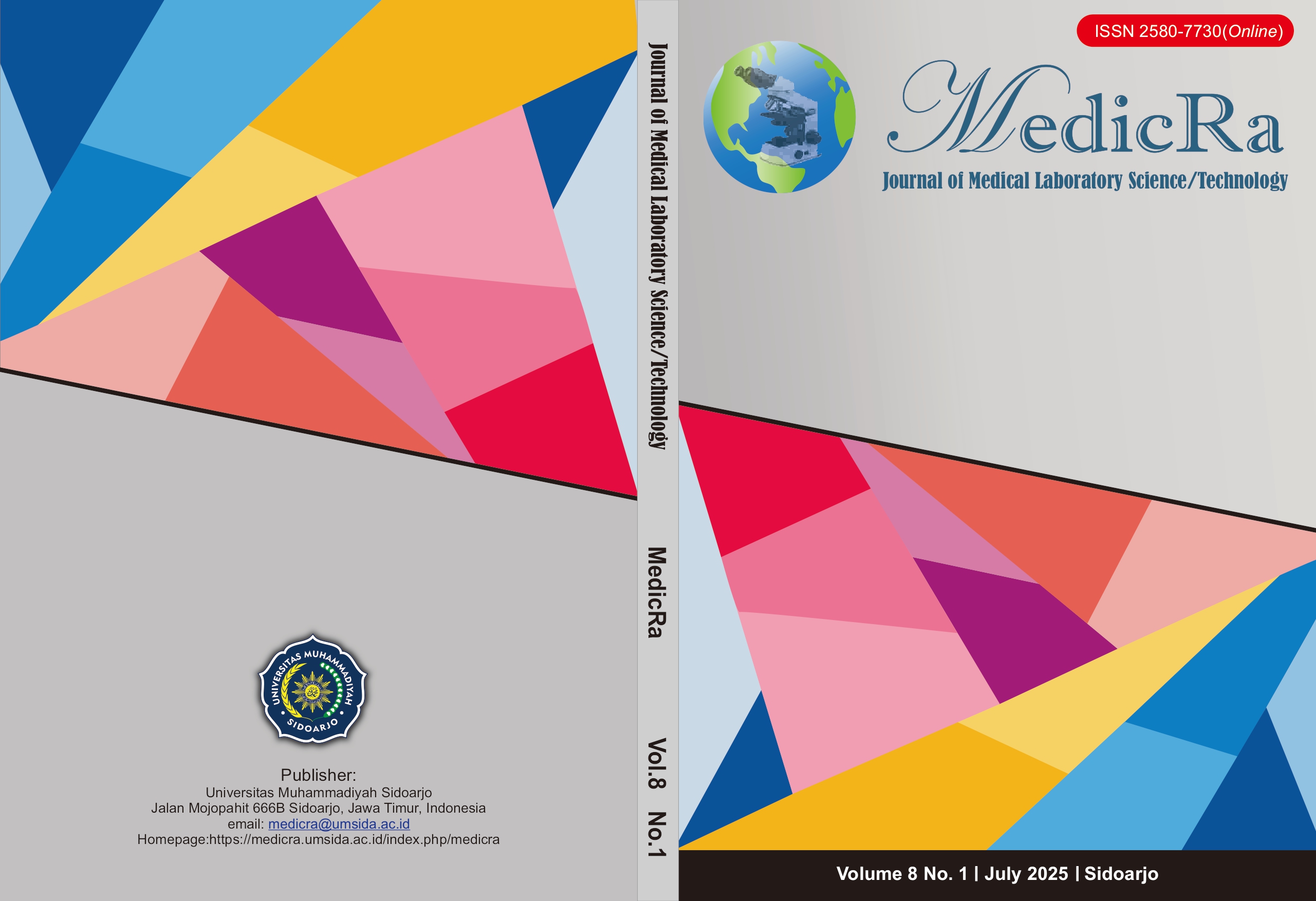Relationship between Knowledge Level and Incidence of Skin Diseases
Hubungan Tingkat Pengetahuan Terhadap Kejadian Penyakit Kulit
DOI:
https://doi.org/10.21070/medicra.v8i1.1785Keywords:
Behavior, Sanitation, TropicalAbstract
Onychomycosis is a fungal infection of the nail frequently found in tropical regions and may negatively impact community health and quality of life. This study aimed to examine the association between public knowledge and the incidence of onychomycosis in Banjar Dinas Batang, Karangasem Regency. An analytical observational design with a cross-sectional approach was employed. A total of 30 adults were selected using purposive sampling based on inclusion criteria. Knowledge levels were assessed using a closed-ended questionnaire, and laboratory diagnosis was confirmed through culture on Sabouraud Dextrose Agar and microscopic observation with Lactophenol Cotton Blue staining. The results revealed that 60% of participants had nail fungal infections, most commonly in those with low knowledge levels (66.7%). Statistical analysis showed a significant association between knowledge and infection incidence (p = 0.045; PR = 4.25). Identified fungal species included Aspergillus spp., Zygomycetes, and yeasts. These findings suggest that limited knowledge increases the risk of onychomycosis. Community-based health education is essential to promote preventive behavior, especially in moist environments that favor fungal growth.
References
Badan Penelitian dan Pengembangan Kesehatan. (2019). Laporan Nasional Riskesdas 2018. Kementerian Kesehatan Republik Indonesia.
Bodman, M. A., & Krishnamurthy, K. (2024). Onychomycosis. StatPearls Publishing.
Falotico, J. M., & Lipner, S. R. (2022). Updated Perspectives on the Diagnosis and Management of Onychomycosis. Clinical, Cosmetic and Investigational Dermatology, 15, 1933–1957. https://doi.org/10.2147/CCID.S362635
Gupta, A. K. (2020). Onychomycosis in the elderly. Drugs & Aging, 16(6), 397–407. https://doi.org/10.2165/00002512-200016060-00002
Gupta, A. K., Jain, H. C., Lynde, C. W., MacDonald, P., Cooper, E. A., & Summerbell, R. C. (2000). Prevalence and epidemiology of onychomycosis in patients visiting physicians’ offices: A multicenter Canadian survey of 15,000 patients. Journal of the American Academy of Dermatology, 43(2), 244–248. https://doi.org/10.1067/mjd.2000.104794
Gupta, A. K., Mays, R. R., Versteeg, S. G., Piraccini, B., A. Takwale, A. S., Babaev, M., Grover, C., Chiacchio, N. D. Di, Taborda, P., Taborda, V., Shear, N., Piguet, V., & Tosti, A. (2018). Global perspectives for the management of onychomycosis. International Journal of Dermatology, 58(10). Doi: doi.org/10.1111/ijd.14346
Hartini, M. T., Indrastiti, R., & Purnamasari, R. (2023). Relationship Level Of Knowledge, Attitude And Behavior To The Incidence Of Scabies At The Al Fatih Klaten Modern Islamic Boarding School. Jurnal EduHealth, 14(04), 209–215. Retrieved from://ejournal.seaninstitute.or.id/index.php/healt/article/download/3144/2487
Islam, N. (2017). A Cross Sectional Studyon Awareness Level of Onychomycosis Patients. Journal of Clinical and Investigative Dermatology, 5(2), 01–03. Doi: 10.13188/2373-1044.1000048
Kang, S., Amagai, M., Bruckner, A. L., Enk, A. H., Margolis, D. J., McMichael, A. J., & Orringer, J. S. (2012). Fitzpatrick’s Dermatology in General Medicine, 8e. In British Journal of Dermatology (8e ed.). The McGraw-Hill Companies. Retrieved from: https://accessmedicine.mhmedical.com/content.aspx?bookid=392§ionid=41138688
Lee, D. K., & Lipner, S. R. (2022). Optimal diagnosis and management of common nail disorders. Annals of Medicine, 54(1), 694–712. Doi: 10.1080/07853890.2022.2044511
Leung, A. K. C., Lam, J. M., Leong, K. F., Hon, K. L., Barankin, B., Leung, A. A. M., & Wong, A. H. C. (2020). Onychomycosis: An Updated Review. Recent Patents on Inflammation & Allergy Drug Discovery, 14(1),32-45. Doi: 10.2174/1872213X13666191026090713
Mayumi, N. K. S., Habibah, N., & Suyasa, I. N. G. (2023). Identification of Fungus Causing Onychomycosis in Chicken Meat Traders in Traditional Markets. JST (Jurnal Sains Dan Teknologi), 12(1),190-199. Doi: 10.23887/jstundiksha.v12i1.49203
Mufida, D. C., Himma, A., Agustina, D., Armiyanti, Y., & Sofiana, K. D. (2024). The Relationship Between Personal Hygiene and The Prevalence of Tinea Unguium Infection Among Farmers in Jember District. Jurnal Profesi Medika : Jurnal Kedokteran Dan Kesehatan, 18(1), 44–50. Doi: 10.33533/jpm.v18i1.7514
Oi, S., Rizkifani, S., & Nurmainah. (2019). Kajian Tingkat Pengetahuan Dan Perilaku Swamedikasi Maag Pada Mahasiswa Kesehatan. Jurnal Mahasiswa Farmasi Fakultas Kedokteran UNTAN, 4(1), 2–12. Retrieved from https://jurnal.untan.ac.id/index.php/jmfarmasi/article/view/47106
Olbrich, M., Ernst, A. L., Beltsiou, F., Bieber, K., Ständer, S., Harder, M., Anemüller, W., Köhler, B., Zillikens, D., Busch, H., Künstner, A., & Ludwig, R. J. (2022). Biodiversity of mycobial communities in health and onychomycosis. Scientific Reports, 12(1), 8872. Doi: 10.1038/s41598-022-13074-8
Piraccini, B. M., & Alessandrini, A. (2015). Onychomycosis: A review. Journal of Fungi, 1(1), 30–43. https://doi.org/10.3390/jof1010030
Scher, R. K., Daniel, C. R., Rubin, A. I., & Jellinek, N. J. (2018). Nails: Diagnosis, Surgery, Therapy (5th ed.). Berlin: Springer International Publishing.
Williams, S. L., Toda, M., Chiller, T., Brunkard, J. M., & Litvintseva, A. P. (2024). Effects of climate change on fungal infections. PLoS Pathogens, 20(5), 1–7. Doi: 10.1371/journal.ppat.1012219
Conflict of Interest Statement: The authors declare that the research was conducted in the absence of any commercial or financial relationships that could be construed as a potential conflict of interest.
Copyright © 2025 Prasetya and Abadi. This is an open-access article distributed under the terms of the Creative Commons Attribution License (CC BY). This is an open-access article distributed under the terms of the Creative Commons Attribution License (CC BY). The use, distribution or reproduction in other forums is permitted, provided the original author(s) and the copyright owner(s) are credited and that the original publication in this jour- nal is cited, in accordance with accepted academic practice. No use, distribution or reproduction is permitted which does not comply with these terms.s
Downloads
Additional Files
Published
How to Cite
License
Copyright (c) 2025 Didik Prasetya

This work is licensed under a Creative Commons Attribution 4.0 International License.






